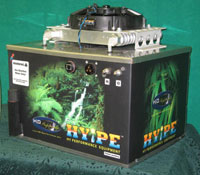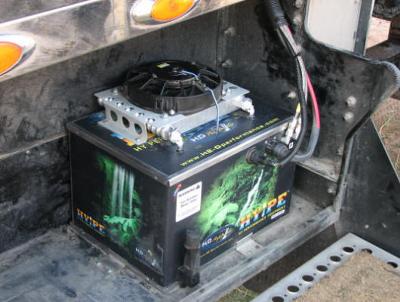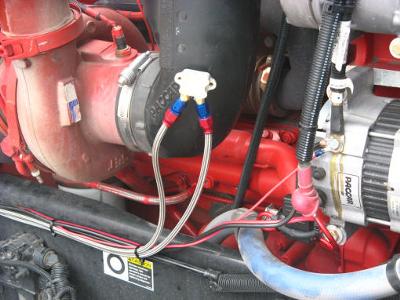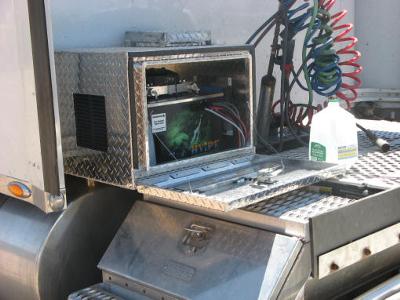H2O Performance Manufactures Fuel Assist Fuel Cells
by Dennis

HYPE Fuel Cell
Wet Jet Precision's Customer Loyalty Program uses their new product marketing to highlight H20 Performance's Fuel Cell technology . . .
H2O Performance . . . creates real performance from real hydrogen. Their new fuel cell is designed to assist and enhance fuel combustion.
The HYPE II Trucker Machine was engineered and manufactured to generate hydrogen and oxygen from water. These two gases are injected into diesel powered "Big Rigs".
The combination of diesel fuel, hydrogen, and oxygen are particularly effective in providing substantial economic benefits, significant environmental benefits, and extending engine life.
The following report was recently delivered to H2O Performance from Dixie Applied Technology College in St. George, Utah.
The report follows verbatim:
Conclusion of H20 Performance testing
Prior to Grant funding of the H2O project, a great deal of market research was conducted by the company, and
three important observations were documented:
1) The market for this product was present for the following two reasons: it would reduce the cost of fuel consumptions by billions of dollars in the North American market alone and it would reduce green-house gases. The latter reason will be very valuable in the future as restrictions on emissions are put in place, but the former presented an immediate need and a market that was easier to penetrate.
2) There were many products similar to this product that had diminished the prospects of mass commercialization by implementing poorly constructed products that cause costly damage to the engines that they were placed in. This hampered the trust between the inventor and the truck owner.
3) Scientific studies with controlled elements had been conducted and the results were conclusive that hydrogen injection into the fuel stream reduced emissions, and increased mileage and engine performance.
Based upon these three observations, it was determined that the key to penetrating this market and
commercializing the H2O product was not to promote the scientific evidence found in the controlled studies, but to counter the negative relationship established by previous products and the essential willing participant by implementing units on voluntary participants at no or minimal cost and gathering real-world information from the implementation of the units including: emissions (CO2, CO, O2,NOx,) and engine performance.
This type of study would have a two-fold effect:
1) It would add to the data of hydrogen emissions implementation albeit through a less than scientific method, and
2) more importantly, if it were successful, it would generate positive word-of-mouth enthusiasm for the implementation of this product.
A real-world study needed to include real-world scenarios such as variety in truck and engine. The study was done under the direction and supervision of Damon Atkinson, an ASE certified Master Truck Technician and Diesel mechanics instructor at the Dixie Applied Technology College in St.George, Utah. The H2O device was installed on the following trucks:
Engine: 3406E Cat 550 Horsepower, Truck: 1998 Peterbilt
Engine: ISX Cummins 500 Horsepower, Truck: 1998 Peterbilt
Engine: 3406E Cat 500 Horsepower, Truck 1997 Kenworth
Engine: Duramax LBZ, Truck: 2007 Chevrolet
Engine: 7.3L Powerstroke, Truck: 2000 Ford
A variety of engines with real world scenarios are accompanied by real world problems. A number of companies in our local area were willing to participate in our study, but every company offered limited access to the trucks in their fleet, and every company mitigated their risk by limiting the number of trucks the H2O (Hype) product was installed on to only one or two trucks within the fleet.
Given these conditions, it became evident that gathering all the information we intended to collect in a study such as this would require a full-time staff of more than one person to organize, track and coordinate the schedules of half a dozen individuals in various locations working for various companies and traveling various routes. With limited resources, this level of coordination proved impossible to achieve.
The observations from the instructor that conducted the study are as follows:
Opacity: During the testing for Particulate Matter reduction or Opacity, all of the testing went as planned with the exception of equipment failure during the Corsa truck final run in which we were unable to perform the final snap test. The results show significant improvement on average with the Hype unit installed and running during the snap tests. Improvements were greater on engines of lesser displacement while larger displacement engines did not show improvement and the largest engine showed higher opacity during full load runs on the dynamometer. However the ambient temps were considerably higher during final testing of the largest engine and were a
contributing factor.
NOx: Testing for NOx went as planned with no apparent problems. The reduction in NOx was significant in all testing conditions and in all engines with the exception of the largest two engines at full load. However ambient
temperatures were much higher on these engines during the second test than during the first and were a contributing factor. Full load is a condition where a truck would spend the least amount of time during operation.
CO2: Although the testing did not target this emission it is noteworthy that in all conditions and engines CO2
reductions were apparent.
Horsepower: Horsepower tests were done on the Dynamometer at Wheeler machinery in Hurricane, Utah. Three runs were done to find the average and that number was recorded. Although there was no significant increase in peak horsepower or torque, there was a noted difference when the torque reached its peak in all cases. The torque reached its peak sooner in all cases. This researcher believes this is what attributes to the more responsive feel that has been reported by the drivers and most likely the cause of the increased mileage.
Quality of product: This researcher has scrutinized the HYPE unit inside and out and has looked at the quality of workmanship as well as the safety of the unit, although the main goal in testing was if the HYPE met expectations and to what degree. This researcher found the fit and finish to be of the highest quality of any aftermarket product I have ever installed. The ease of installation, operation and use was also found to be more than acceptable.
I found that the HYPE operated flawlessly in my vehicle as well as the trucks in which we tested it. I could get
about 24 hours of operation between fill ups of water and found that the exhaust temps ran lower in my personal vehicle. I also noted an increase in mileage and a perception of increased power.
Damon J Atkinson
Diesel Technology Instructor
For additional information on H2O Performance and their hydrogen products go to the H2O Performance website.






